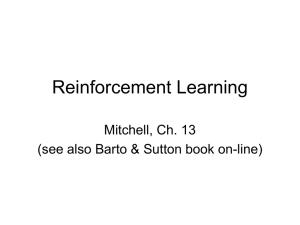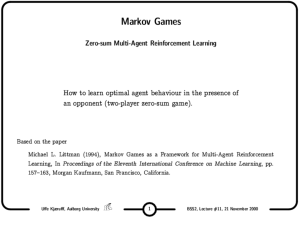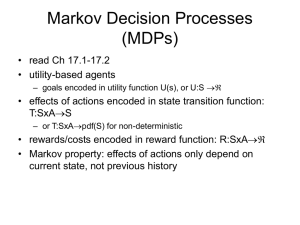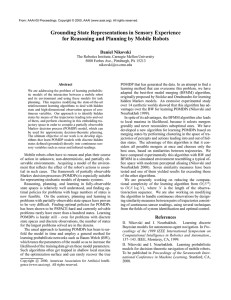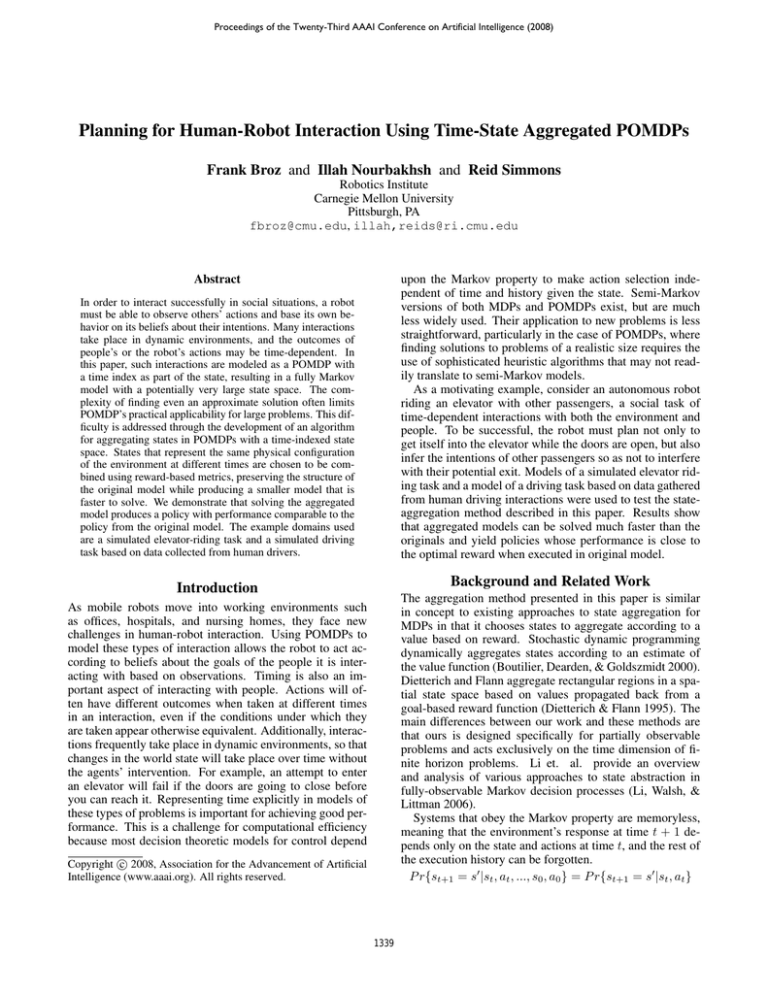
Proceedings of the Twenty-Third AAAI Conference on Artificial Intelligence (2008)
Planning for Human-Robot Interaction Using Time-State Aggregated POMDPs
Frank Broz and Illah Nourbakhsh and Reid Simmons
Robotics Institute
Carnegie Mellon University
Pittsburgh, PA
fbroz@cmu.edu, illah,reids@ri.cmu.edu
Abstract
upon the Markov property to make action selection independent of time and history given the state. Semi-Markov
versions of both MDPs and POMDPs exist, but are much
less widely used. Their application to new problems is less
straightforward, particularly in the case of POMDPs, where
finding solutions to problems of a realistic size requires the
use of sophisticated heuristic algorithms that may not readily translate to semi-Markov models.
As a motivating example, consider an autonomous robot
riding an elevator with other passengers, a social task of
time-dependent interactions with both the environment and
people. To be successful, the robot must plan not only to
get itself into the elevator while the doors are open, but also
infer the intentions of other passengers so as not to interfere
with their potential exit. Models of a simulated elevator riding task and a model of a driving task based on data gathered
from human driving interactions were used to test the stateaggregation method described in this paper. Results show
that aggregated models can be solved much faster than the
originals and yield policies whose performance is close to
the optimal reward when executed in original model.
In order to interact successfully in social situations, a robot
must be able to observe others’ actions and base its own behavior on its beliefs about their intentions. Many interactions
take place in dynamic environments, and the outcomes of
people’s or the robot’s actions may be time-dependent. In
this paper, such interactions are modeled as a POMDP with
a time index as part of the state, resulting in a fully Markov
model with a potentially very large state space. The complexity of finding even an approximate solution often limits
POMDP’s practical applicability for large problems. This difficulty is addressed through the development of an algorithm
for aggregating states in POMDPs with a time-indexed state
space. States that represent the same physical configuration
of the environment at different times are chosen to be combined using reward-based metrics, preserving the structure of
the original model while producing a smaller model that is
faster to solve. We demonstrate that solving the aggregated
model produces a policy with performance comparable to the
policy from the original model. The example domains used
are a simulated elevator-riding task and a simulated driving
task based on data collected from human drivers.
Background and Related Work
Introduction
The aggregation method presented in this paper is similar
in concept to existing approaches to state aggregation for
MDPs in that it chooses states to aggregate according to a
value based on reward. Stochastic dynamic programming
dynamically aggregates states according to an estimate of
the value function (Boutilier, Dearden, & Goldszmidt 2000).
Dietterich and Flann aggregate rectangular regions in a spatial state space based on values propagated back from a
goal-based reward function (Dietterich & Flann 1995). The
main differences between our work and these methods are
that ours is designed specifically for partially observable
problems and acts exclusively on the time dimension of finite horizon problems. Li et. al. provide an overview
and analysis of various approaches to state abstraction in
fully-observable Markov decision processes (Li, Walsh, &
Littman 2006).
Systems that obey the Markov property are memoryless,
meaning that the environment’s response at time t + 1 depends only on the state and actions at time t, and the rest of
the execution history can be forgotten.
P r{st+1 = s0 |st , at , ..., s0 , a0 } = P r{st+1 = s0 |st , at }
As mobile robots move into working environments such
as offices, hospitals, and nursing homes, they face new
challenges in human-robot interaction. Using POMDPs to
model these types of interaction allows the robot to act according to beliefs about the goals of the people it is interacting with based on observations. Timing is also an important aspect of interacting with people. Actions will often have different outcomes when taken at different times
in an interaction, even if the conditions under which they
are taken appear otherwise equivalent. Additionally, interactions frequently take place in dynamic environments, so that
changes in the world state will take place over time without
the agents’ intervention. For example, an attempt to enter
an elevator will fail if the doors are going to close before
you can reach it. Representing time explicitly in models of
these types of problems is important for achieving good performance. This is a challenge for computational efficiency
because most decision theoretic models for control depend
c 2008, Association for the Advancement of Artificial
Copyright Intelligence (www.aaai.org). All rights reserved.
1339
Mahadevan 2001). Continuous-state POMDPs with hybrid
dynamics use a switching state-space model to allow statedependent differences in the next-state distribution (Brunskill et al. 2008). These models could also be used to represent time-dependent actions, though their transition model
is not well suited for cases where the state dynamics may
change abruptly. A drawback to using specialized model
forms to represent time-dependence is that one cannot directly apply the general POMDP solution algorithms designed for discrete, fully Markov models.
Semi-Markov models are a generalization of Markov models that allow the time spent in a state to be represented by
an arbitrary probability distribution and the state transition
probabilities to be dependent on the time that has been spent
in that state (Puterman 1994). In a Markov model, time spent
in a state can be modeled only as a self-transition, which has
an exponential distribution. One way of avoiding this limitation is to transform the semi-Markov model into an approximately equivalent fully Markov model. For instance,
Younes finds approximate solutions for generalized semiMarkov decision process models by replacing each semiMarkov state with a phase type distribution, a series of fully
Markov states that approximate a continuous distribution,
and then solving the resulting continuous-time Markov decision process (Younes & Simmons 2004). This work has
only been applied to fully observable planning problems.
However, phase type distributions have been used by Duong
et.al. to approximate hidden semi-Markov models for action
recognition of everyday household activities (Duong et al.
2005).
In the discrete time case, it is possible to represent time
dependent action outcomes and arbitrary distributions over
time spent in a state in fully Markov models by making
time part of the state space. The most straightforward way
to do this in a finite horizon problem is to add a global
time index variable to the state space. This approach to
representing time is simple and flexible, at the cost of potentially creating very large models that are expensive to
solve. McMillen and Veloso developed an algorithm using a
time-indexed state to find time-dependent policies for finite
horizon MDPs in a robotic soccer application (McMillen &
Veloso 2007). The MDP’s state space is expanded by adding
the time remaining and intermediate reward to the state. In
order to manage the increase in size, they use heuristic methods that compress the time horizon according to a fixedcriteria (such as compressing uniformly or compressing the
early timesteps). While the policies obtained by this method
are time-dependent, the policy of the opponent and the environment described in the model are not. Our focus on
human-robot social interaction makes this simplification untenable. Our approach also differs in that the time index used
is based on chronological time rather than horizon, states
are combined based on their value, and the models used are
POMDPs rather than MDPs.
POMDPs are a type of Markov decision process that can
model situations in which an agent acts without complete
knowledge of the current state of its environment(Kaelbling,
Littman, & Cassandra 1998). Though solving for even approximately optimal POMDP policies is very expensive,
there are now a number of POMDP solution algorithms that
can achieve good performance on reasonably large models. POMDPs have been applied to human-robot interaction domains, such as dialogue management for a robot that
interacts with the elderly in a nursing home (Pineau et al.
2003) and an automated system that assists people with dementia in performing everyday tasks (Boger et al. 2005).
Temporally extended actions, represented as semi-Markov
states, have been used as a form of hierarchical abstraction in POMDPs (Hansen & Zhou 2003; Rohanimanesh &
Time-state Aggregation
A POMDP model without time as part of the state would
be significantly smaller than a time-indexed model, and one
might expect that a model with fewer states but the same
number of observations and actions would be faster to solve.
But without the time index, time dependent aspects of the
problem can not be accurately represented by the model,
which may reduce the solution quality. It is likely that all
action outcomes are not time dependent in all states. It is
also possible that it is not uniformly important to represent
this time dependence throughout the state space in order to
obtain a policy that performs well.
If one knew which states needed to model time-dependent
transitions in order to achieve good performance, one could
abstract away the time information in the states that did not
matter. Acting on that intuition, we designed a state aggregation algorithm that operates exclusively in the time dimension of the state space. States are scored with a value based
on their future achievable reward, and these values are used
to identify sets of states to be combined. This algorithm
attempts to minimize the effect of the aggregation on the
quality of the policy obtained from the resulting model by
only combining states that are likely to lead to similar future
rewards.
A POMDP is typically defined as a tuple made up of sets
of states, actions, and observations and the matrices of probabilities over the observations, state transitions, and rewards.
{S, A, O, O(o, s, a), T (s, a, s0 ), R(s, a)}
In a time-indexed POMDP model, the state can be thought
of as being made up of two distinct sets of state variables,
those that describe the state of the environment , svi ∈ E,
and a singleton set, T , of the variable that represents the
time index.
N
S=E
T where sv1 , ...svn ∈ E and t ∈ T
The resulting POMDP contains many states that have the
same values for all state variables except t. We will refer to
states having this property as physically identical. We assume that our observations are not time dependent, so if two
states S1 and S2 are physically identical, their observation
probabilities will also be identical.
O(o, S1, a) = O(o, S2, a)∀a∀o
A sequence of physically identical states that transition
from one to the next under a certain action represent the
amount of time that will be spent in that physical state when
that action is chosen. These states are equivalent to one
1340
semi-Markov state with a step function for a time distribution that transitions from 0 to 1 after n timesteps, where n
is the length of the state sequence. This is illustrated in Figure 1 for n = 3. In Markov models, the expected time in a
state can be modeled only as a self-transition, which follows
an exponential distribution. Setting the probability of selftransition to n−1
n will make the time spent in the state equal
n in expectation, but the variance will be n2 .
Time
t
t+1
p = 0.7
the average of that action’s transition probabilities from each
state of the original set, with the exception that all state transitions from one state in the set to another are replaced by
self-transitions in the new state. Once the new transition
matrix including the combined states is constructed, it is
repaired so that any transitions into deleted states are redirected to the combined state that they were replaced by. The
details of the algorithm are given in Table 1. The combine()
function evaluates the states according to some metric to decide whether they should be merged. If the function always
returns true, the resulting model will have the time index
variable completely removed from the state space.
t+2
p = 0.7
p = 0.7
E[S1] = 50
MDP
{ a, b, a or b }
p = 0.3
p = 0.3
p = 0.3
S1
S2
a
b
SMDP
p =0
p =0
S3
a
a, b
b
10
p =1
S1'
S2'
a, b
-100
S3'
a,b
END
a, b
Figure 1: A Markov state approximates a semi-Markov
state’s time distribution with a self-transition.
50
S1''
Combine states
Tnew , a state-transition matrix, is initialized to all zeroes
deleted is an empty hash table
S2''
a, b
a, b
E[S] = 10
for t in 1:T
for s in St
if s in deleted
s = deleted(s)
for s0 in succs(s)
if combine(s, s0 )
for a in A
Tnew (s, a, s) += T (s, a, s0 )
for o in O
Onew (o, a, s) = O(o, a, s0 )
deleted(s0 ) = s
else
Tnew (s, a, s0 ) += T (s, a, s0 )
a, b
2/3
{ a, a, a, ... }
1/3
S3''
a
S
b
a, b
10
1/3
1/3
-100
S'
2/3
a, b
1/3
S''
END
1/3
50
a, b
2/3
Figure 2: A model (top) and its equivalent model without a
time index (bottom) and their optimal policies.
A combined state approximates a set of physically identical states as one state that has a non-zero probability of
transitioning to a successor of the states in the original sequence after any timestep. The policies obtained by solving
the aggregated model may not perform well compared to
policies from the original model if the aggregated model is
a poor approximation. Consider the example in Figure 2 ,
which uses fully observable state for simplicity of explanation. The model on top is made up of three states whose
action outcomes change over the course of three time steps.
The model on the bottom represents the same physical states
and actions without the time index. States S1, S2, and S3
are combined into state S. Notice that the deterministic,
time-dependent actions in the original model become nontime-dependent actions with probabilistic outcomes in the
new model. The new model’s optimal policy (always execute action a) is different from the optimal policy for the
original model, which requires b to be the action chosen
at the second timestep. The expected reward for the new
model’s policy is 10 in both the new and the original model.
But the original model’s optimal expected reward is 50.
Ideally, we would like to measure the sensitivity of the
solution to the representation of time and only keep multi-
Repair state transition matrix
for s ∈ S
if s not in deleted
for a in A
for s0 in succs(s, a)
s00 = s0
while s00 in deleted
s00 = deleted(s00 )
Tnew (s, a, s00 ) = T (s, a, s0 )
Remove rows and columns of deleted states from matrices
Renormalize Tnew so it is a well-formed probability matrix
Table 1: Description of the time-state aggregation method.
For the state combination criteria used, see Table 2.
The state aggregation method we describe is based on the
transformation of sequences of states into a single state. The
new state’s state transition probabilities for each action are
1341
of states, which means that the action executed in a particular state will not always be the optimal action for that state.
Initially, states are assigned the value of the reward for
that state. The values are propagated backwards in time
through the model as described in Table 2. The model is then
compressed using the same process described in Table 1, except that a reward-based criteria is used to decide whether to
combine two states rather than just a test of whether they are
physically identical. The state values are calculated using
either expected reward or KL divergence of the reward under the random policy. KL divergence is a more informative
metric, but it is only appropriate for problems in which the
distribution over rewards can be easily represented (such as
when they are restricted to a small set of possible values assigned at the end of a trial). For either criteria, the decision
to combine states is controlled by a threshold on the difference in values. This threshold can be varied to get the desired reduction in the number of states, limited by the size of
the model with no time index. The expected reward criteria
Criteria for combining states
combine(s, s0 )
if physically identical(s, s0 ) and
compare(s, s0 , a) < threshold ∀a ∈ A
return true
else
return f alse
Expected reward (ER)
for t in T -1:downto:1
for s in St
for a in A
V (s, a) = R(s, a) +
P
T (s, a, s0 ) ∗ V (s0 )
s0 ∈St+1
V (s) =
1
|A|
P
V (s, a)
a∈A
compare(s, s0 , a)
abs(V (s, a)) − V (s0 , a))
KL divergence (KL)
Let Vs (k) = P r{R(s) = rk } for s in ST
for t in T -1:downto:1
for s in St
for a in A
P
E[S1] = 50
{ a, b, a or b }
T (s,a,s0 )∗Vs0 (k)
s0 ∈St+1
Vs,a (k) = P
P
S1
T (s,a,s0 )∗Vs0 (k)
V(S1) = -35
k s0 ∈St+1
1
|A|
Vs (k) = P
k
P
Vs,a (k)
S1'
a∈A
1
Vs,a (k)
|A|
a∈A
a
b
S2
V(S2) = 30
S2'
a
b
S3
a, b
10
V(S3) = 10
-100
S'
2/3
P
V(S1') = -100
V(S2') = -100
1/3
V(S') = -100
a, b
50
1/3
compare(s, s0 , a)
KL(Vs,a (), Vs0 ,a ())
S1''
V(S1'') = 50
S2''
V(S2'') = 50
S''
a, b
2/3
V(S'') = 50
Figure 3: The model from Figure 2, after value-based
aggregation.
Table 2: Criteria used to select which states to combine.
ple time-indexed states when they have an impact on the reward that can be achieved. We do not want to combine two
states if different actions would be chosen in each state by
the optimal policy, but we cannot know this without knowing what the optimal policy is . We hypothesize that one
indirect measure of the significance of the time index may
be the variation in reachable future rewards. Two physically
similar states should not be aggregated if there is a large
difference in the values of the rewards they could possibly
encounter in the future (which likely correlate with different
task outcomes).
with a threshold of 0 is used to aggregate states of the model
from Figure 2 in Figure 3. Note that in this case the optimal policy and expected reward for this model are identical
to the original’s. It is not guaranteed that the optimal policy
for a state-aggregated model will be identical to that of the
original model, or that it will achieve the same reward. But
experimental results show that these policies perform reasonably close to optimal on the original models at levels of
aggregation that give significant speed-ups in solution time.
Experimental Results
It is desirable to have states be combined only if choosing
the same action in each of them will yield the same or similar reward. In the absence of the optimal policy, it seems
reasonable to compare actions based on achievable reward
rather than optimal reward. Therefore, the value for an action in a state is calculated to be the expected reward of taking that action from that state and then following a random
policy afterwards. Because a random policy will explore all
reachable states, the value will represent a combination of all
future rewards possible from that state after taking that action. It is important to base the heuristic on all future rewards
rather than the best future reward because a POMDP policy
chooses the best action based on its current belief over a set
Description of experimental domains
The elevator domain is a simplified version of the task of entering an elevator occupied by human passengers for a mobile robot. The state space is made up of the robot’s and
people’s positions, whether each person intends to exit, and
the current timestep.The robot receives an observation at every timestep that indicates that the closest person in front of
it is moving, that the person is stopped, or that the elevator is empty of people. A person may hesitate for several
timesteps before starting to move and before exiting the elevator. The robot’s action choices are to wait or move forward. The move action is assumed to succeed unless the
1342
Table 3: Comparison of the sizes of the state-aggregated
models as percentages of the number of states of original
models for the elevator domain.
models
avg % (min %, max %)
KL 0.001
33
(20, 42)
KL 0.02
22
(12, 30)
KL 0.045
19
(10, 26)
9
(5, 12)
No time
robot attempts to move into a position currently occupied by
a person or into the doorway when the door is closing. If
the robot and a person meet in the doorway, they will both
be stuck until the door closes and the trial ends. The robot
receives a one-time reward based on whether it succeeded
in getting on the elevator. Because the robot should not improve its performance at the expense of those it is interacting
with, it is also penalized for each person it prevents from exiting. Models of different state size are created by varying
the number of people, the period of time that each person
may hesitate before moving, the length of time the door stays
open, and the resolution of the grid defined over the elevator
and lobby.
Another, less widely known navigation-based social interaction is the ”Pittsburgh left”. According to this local driving convention, a car may choose to yield and allow the car
opposite it at an intersection to make a left turn as soon as
the traffic light turns green. Drivers observe each other for
behavioral cues (such as speed of approach or flashing headlights) as to whether a car wants to take the Pittsburgh left
and whether the other car will allow it. The Pittsburgh left
problem domain is a driving task from the perspective of the
driver attempting to make a left. The state is made up of information about both cars (such as their positions and velocities), whether the oncoming car’s intends to allow the Pittsburgh left, the traffic light color, and the current timestep.
The physical state of the other car and the traffic light is observable, but the other car’s intention is not. The turning
car’s action choices are to move at one of 3 speeds (stopped,
slow, or fast), turn, or continue at their present speed and angle. Each interaction begins when the traffic light is red and
ends when it turns red again. The turning car gets its greatest reward if it makes the Pittsburgh left, a lesser reward for
turning after the other car passes the intersection, and no reward for failing to go through the intersection. There are
also penalties for running the red light or colliding with the
oncoming car. The POMDP model for this domain was created by combining a prior model based on expert knowledge
with data from 30 human drivers performing a Pittsburgh
left driving interaction in a driving simulator.
3
10
Original
KL 0.001
2
10
KL 0.02
Time to policy convergence (sec)
KL 0.045
1
10
0
10
−1
10
−2
10
−3
10
3000
4000
5000
6000
7000
8000
States in original model
9000
10000
11000
Figure 4: The relationship between the value difference
threshold for merging states and their solution time for the
elevator domain POMDP models
of compression in Figure 4.
The figure clearly shows that the compressed models converge to a solution considerably faster than the original.
Other levels of compression were also evaluated, and their
performance followed the trend of this representative subset.
Interestingly, the models at the intermediate compression
level (KL 0.02) consistently converged the fastest. Levels
of compression above KL 0.045 converged more and more
slowly until their performance matched that of the models
without a time index, which failed to converge to an optimal policy within the 1,000 second time limit set for these
experiments. The reason for this somewhat surprising result
is based on the structure of the original models. In this synthetic example domain, the action outcomes are relatively
deterministic.
When sets of states are combined, the state transitions out
of each original state become state transitions out of the new
state. The self-transition that the new state uses to represent the expected time in the state also increases the uncertainty of that action’s outcome. At some point, the cost
of the larger number of action outcomes and greater uncertainty outweighs the benefit of having fewer states in the
model. The policies from the aggregated models were executed in the original model. Policies at all threshold levels
performed close to the policy of the original model. The rewards obtained by the policies for the no time index models
were lower than the rewards obtained by policies from the
less compressed models by a statistically significant amount
in most cases, but all of the models’ rewards were close in
absolute terms. This seems to be due to the relative simplic-
Comparison of model performance
Time-indexed POMDP models were generated for 12 variations of the elevator riding problem ranging from around
4000 to 10,000 states in size. The threshold for comparison of KL divergence was varied to obtain multiple levels of
compression. Because both of the state comparison criteria
(expected reward and KL divergence) performed similarly
in this domain, we will only report the results for KL divergence, with the understanding that the same overall trend
also applies when using expected reward. For a comparison
of the number of states in the original and aggregated models, refer to Table 3. The ”no time” models are the models in
which the time index is completely removed from the state
space. The models were solved for their optimal policies
using the ZMDP solver with the FRTDP heuristic (Smith
2007). The time to convergence of the policies (defined as
the time at which the upper and lower bounds on the policy
become approximately equal) are compared at various levels
1343
for the original model, and potentially much better than a
model with no time index of a similar size.
In future experiments, the performance of policies from
state-aggregated models will be compared to policies from
the original models while controlling agents in a driving
simulator interacting with human drivers. Further analysis
of the compression algorithm will seek to provide performance guarantees for policies obtained from the aggregated
model with respect to the original model.
ity of the elevator domain.
Table 4: Solution time and policy performance (with 95%
confidence intervals) for the Pittsburgh left model.
Model
No Time
ER 10.0
ER 5.0
ER 2.0
Original
States
3762 (14%)
5022 (18%)
9137 (33%)
14311 (52%)
27506
Reward
-3.8 [-4.9, -2.7]
1.3 [1.0, 1.5]
1.4 [1.1, 1.6]
1.3 [1.0, 1.5]
1.9 [1.7, 2.0]
Time (s)
1325
17663
27128
143304
164088
Acknowledgments
Thanks to Trey Smith for providing the ZMDP software(Smith 2007) and offering support in its use.
The results for the Pittsburgh left domain are summarized
in Table 4. Versions of the model aggregated with different
thresholds were solved, and their policies were executed on
the original model. The reward structure was more complex
than for the elevator domain, so the expected reward criteria
was used rather than KL divergence. All of the models with
threshold less than 10 achieved higher rewards than the version without a time index, proving that the representation of
time is critical to good performance in this domain. Further
reducing the threshold size did not yield more reward before
the time needed for the policies to converge approached that
of the original model. In this domain, some time-dependent
state structure must be lost in order to reduce the model size
enough to speed up policy convergence. Note that the relationship between the level of compression and the time
needed for the policy to converge is monotonic, unlike in
the elevator domain. Because the original POMDP model is
more realistic than the elevator models, the action outcomes
are sufficiently nondeterministic that the state aggregation
is not penalized in performance for increasing nondeterminism. The differences between these two domains show that
the time required to find a policy for a certain value threshold
and the performance of that policy are dependent on problem structure.
References
Boger, J.; Poupart, P.; Hoey, J.; Boutilier, C.; Fernie, G.;
and Mihailidis, A. 2005. A decision-theoretic approach to
task assistance for persons with dementia. In IJCAI.
Boutilier, C.; Dearden, R.; and Goldszmidt, M. 2000.
Stochastic dynamic programming with factored representations. Artificial Intelligence 121(1-2):49–107.
Brunskill, E.; Kaebling, L.; Lozano-Perez, T.; and Roy, N.
2008. Continuous-state POMDPs with hybrid dynamics.
In Symposium on Artificial Intelligence and Mathematics.
Dietterich, T. G., and Flann, N. S. 1995. Explanationbased learning and reinforcement learning: A unified view.
In ICML, 176–184.
Duong, T. V.; Bui, H. H.; Phung, D. Q.; and Venkatesh,
S. 2005. Activity recognition and abnormality detection
with the switching hidden semi-markov model. In CVPR,
838–845. Washington, DC, USA: IEEE Computer Society.
Hansen, E., and Zhou, R. 2003. Synthesis of hierarchical
finite-state controllers for pomdps. In ICAPS.
Kaelbling, L. P.; Littman, M. L.; and Cassandra, A. R.
1998. Planning and acting in partially observable stochastic domains. Artificial Intelligence 101(1-2):99–134.
Li, L.; Walsh, T. J.; and Littman, M. L. 2006. Towards a
unified theory of state abstraction for MDPs. In Symposium
on Artificial Intelligence and Mathematics.
McMillen, C., and Veloso, M. 2007. Thresholded rewards:
Acting optimally in timed, zero-sum games. In AAAI ’07.
Pineau, J.; Montemerlo, M.; Roy, N.; Thrun, S.; and Pollack., M. 2003. Towards robotic assistants in nursing
homes: challenges and results. Robotics and Autonomous
Systems 42(3-4):271–281.
Puterman, L. M. 1994. Markov Decision Processes. Wiley,
New York.
Rohanimanesh, K., and Mahadevan, S. 2001. DecisionTheoretic planning with concurrent temporally extended
actions. In UAI, 472–479.
Smith, T. 2007. ZMDP software for POMDP and MDP
planning. http://www.contrib.andrew.cmu.edu/ trey/zmdp/.
Younes, H. L. S., and Simmons, R. G. 2004. Solving generalized semi-markov decision processes using continuous
phase-type distributions. In NCAI, 742–747. San Jose, CA:
AAAI Press.
Conclusions and Future Work
This paper examined the relationship between the accuracy
of the representation of time and the complexity of the resulting model in time-dependent domains. An algorithm
was presented for reducing the size of POMDP models that
have a global time index in their state space along the time
dimension. Two heuristics for choosing states to combine
based on the state’s reward values under the random policy
were explored, both of which can be parameterized to allow
control of the amount of aggregation.
The state aggregation method was tested on a number of
models from a synthetic elevator riding domain, as well as
a realistic, data-based model from the Pittsburgh left driving
domain. The models aggregated using value-based heuristics converge to a policy faster than the original models. The
amount of time required for policy convergence is related
to the threshold chosen and the amount of aggregation, so
the threshold can be set to obtain a model of the desired
complexity and performance relative to the original. Empirical results that indicate that policies for various levels of
state aggregation perform well in comparison to the policy
1344


